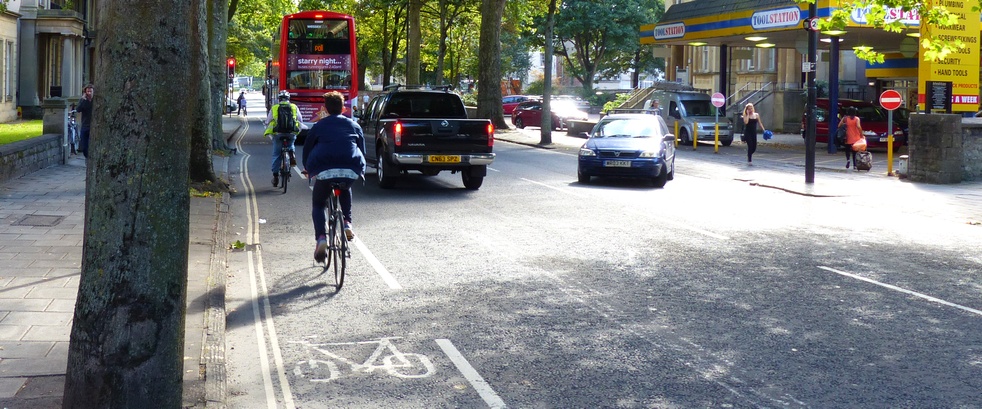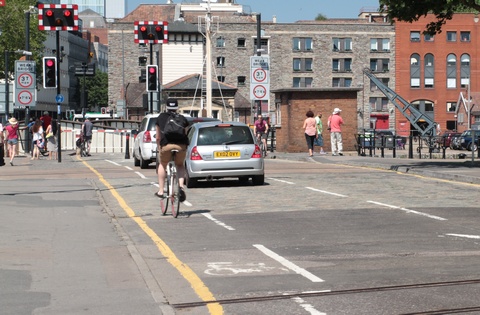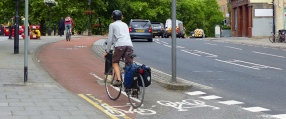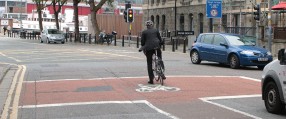Cycle Lanes

Cycle lanes are designated road space for cyclists. The lanes are marked on the road with white paint, and a symbol of a bicycle is frequently spaced throughout the lane. Sometimes cycle lanes are painted red to make them more visible to vehicle drivers, but this could make the street look cluttered.
If a cycle lane has a broken dotted line (an advisory cycle lane), this means motor vehicles are allowed to enter the lane if absolutely necessary. If the cycle lane has a solid white line (a mandatory cycle lane), motor vehicles are not allowed to enter the lane at any time, by law. Motor vehicles are only permitted to park in advisory cycle lanes if it is unavoidable, and there are no parking restrictions.
Restrictions
- The road space must be able to accommodate a 3 metre motor vehicle lane, and at least 1.5 - 2 metres for the cycle lane
- Cycle lanes cannot exist on a road where car parking is permitted (unless car parking spaces are designated)
There's also some general restrictions to note for all schemes
Disadvantages
- May cause cyclists to be less cautious about motor vehicles
- Less road space is available for other uses
Effectiveness
There's very little information about the safety effects of cycle lanes. Designating road space to cyclists does not necessarily prevent cyclist accidents.
Advantages
- Designated road space for cyclists which motor vehicles should not enter
- Allow cyclists to overtake on the inside of vehicular traffic
- Low cost
- May remind motorists that cyclists could be present
- Perceived width of the carriageway is narrowed, which may reduce motorised vehicle speeds
- May give cyclists more confidence to use the road. This provides many benefits, including:
- Improving health of those choosing to cycle
- Reducing motor vehicle congestion
- Reducing pollution from motor vehicles

Advanced information
The lack of literature regarding the safety effects of cycle lanes is highlighted in TRL PPR580 (Reid & Adams, 2011). The authors conclude there is “inadequate” evidence cycle lanes provide a safety benefit in the U.K.
A report presented to the Cycle City Planning Conference by Coates (1999) uses poor evidence, but provides data on the safety effect of early cycle lanes in Oxford, UK at 21 sites. The report suggests a significant reduction in accidents on straight sections of road, but significant increase in accidents both where cycle lanes were carried across junctions and were not carried across junctions. Once again, this is poor evidence which used no control points, and does not provide data regarding cyclist and vehicle flow over the before/after observation period.
A stronger study from Denmark supports this conclusion (Nielsen et al.,1996). Twenty-seven different cycle lanes, spanning 251 junctions were analysed, using; 262 control sites; 2-5 years of before/after data; and correction for change in motorised vehicle traffic flow. The study found a significant reduction in accidents on sections of cycle lane between junctions, but a significant increase in accidents at junctions. Specifically, signalised junctions showed no change in accidents, however T- Junctions with a cycle lanes spanning the straight section showed significant increase in accidents. When cycle lanes span T-junctions in this way, the overall effect of cycle lanes is a 10% reduction in safety for cyclists. This finding should be treated with caution because it is based on relatively few accidents, from a different county to the UK, and did not control for any change in cyclist flow.
References
Coates, N. (1999) The safety benefits of cycle lanes. Proceedings of Velo-City 11th International Bicycle Planning Conference. Austria / Slovenia.
Nielsen, E., Andersen, K., Lei, K. (1996) Trafiksikkerhedseffekten af cykelbaner i byområder, (Rapport 50). Vejdirektoratet, Danmark.
Reid, S. & Adams, S. (2011) Infrastructure and cyclist safety (PPR 580). Transport Research Laboratory. Crowthorne, UK.






